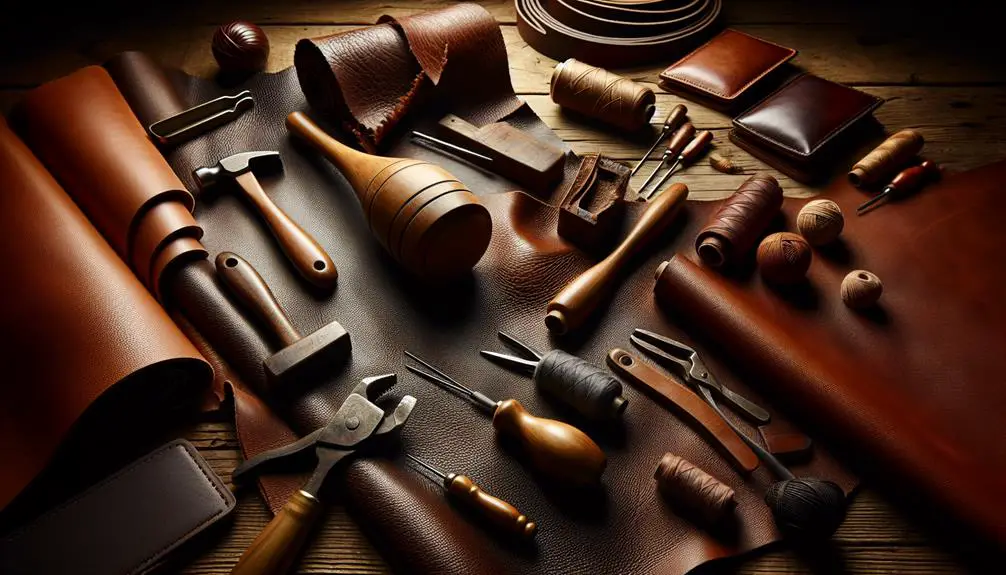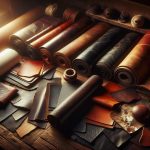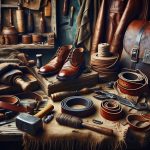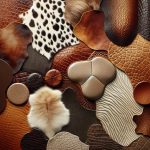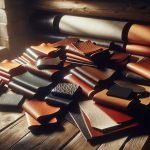In my experience, full-grain leather is the best leather you can get. It's the toughest and most durable type out there, keeping its natural texture and color. What's cool is it develops a unique patina as it ages, which means it just looks better over time. Plus, it's made using the entire hide, so it's a more sustainable choice. I've noticed it's perfect for high-quality items like boots, belts, and bags because it can handle a lot of wear and tear. If you're curious about the nitty-gritty details that make full-grain leather top-notch, there's more to uncover.
Table of Contents
Key Takeaways
- Full-grain leather is considered the best type of leather due to its durability and quality.
- It retains the natural surface of the hide, showing unique textures and imperfections.
- Full-grain leather develops a distinctive patina over time, enhancing its aesthetic appeal.
- This leather type is highly sustainable, utilizing the entire hide with minimal waste.
- It is ideal for high-end products like quality footwear, luxury furniture, and fine accessories.
Understanding Full-Grain Leather
Full-grain leather is the toughest and most durable type of leather you can find. Unlike top-grain leather, which has been sanded down to remove imperfections, full-grain retains the natural texture and color of the hide. This means no two pieces are exactly alike, giving you something truly unique.
What sets full-grain apart is its ability to develop a patina over time. This isn't just about looking better; it's about adding character and depth as the leather ages. It's like a quality wine, improving with time. Plus, this type of leather is incredibly strong. It resists wear and tear, making it perfect for products that need to endure.
Now, let's talk sustainability. Full-grain leather uses the entire hide, reducing waste significantly. It's a more sustainable option compared to other leathers that require more processing and produce more waste. Additionally, its natural composition helps maintain a proper pH balance, adjusting well to body temperatures for added comfort.
Benefits of Full-Grain Leather
Let's talk about why full-grain leather is top-notch.
First off, it's incredibly durable, meaning it lasts a long time without wearing out.
Plus, it looks great; the natural patterns really make each piece stand out.
Durability and Longevity
Boasting unmatched durability, full-grain leather really stands up to daily use and abuse. Its longevity's no joke! The natural fibers keep it robust; they don't break down like in weaker leathers. Plus, it's eco-friendly and sustainable, with minimal waste per hide.
Here's a quick breakdown:
| Feature | Benefit | Why It Matters |
|---|---|---|
| Natural Fibers | High durability | Withstands daily wear |
| pH Balance | Comfort and resilience | Adjusts to body temp |
| Low Waste | Sustainable | Eco-friendly choice |
| Patina Over Time | Enhances charm | Looks better as it ages |
Choosing full-grain leather means investing in quality that lasts and looks great, all while being kind to our planet.
Natural Aesthetic Appeal
The natural beauty of full-grain leather isn't just about looks; it enhances with age, gaining character from every use. Its smooth surface starts off luxurious and grows more so as a unique patina develops, shielding and beautifying at once.
This isn't just any material; it's a sustainable choice, using the least amount of waste per hide. Plus, the way full-grain leather maintains the pH balance and adjusts to your body temperature? That's comfort tailored to your life.
And let's not overlook the natural texture—every inch tells its own story, rich and unmasked. It's clear why this leather stands out. For those who know, full-grain isn't just an option; it's the only way to go.
Comparing Leather Types
When comparing different types of leather, it's clear that full grain leather tops the list for its unbeatable quality and durability. Full grain leather is the real deal; it's strong, lasts a long time, and shows off natural beauty like no other. It's got a texture that tells a story, untouched and pure.
Next up is top grain leather. It's still high quality but doesn't quite match up to full grain. It goes through more processing to get a smoother finish, which means it loses a bit of strength.
Then there's corrected grain leather. It's even smoother because they sand off imperfections. But, this makes it less durable. It looks neat, but it won't hold up as well over time.
Split leather is more about saving cash. It's the bottom part of the hide, so it's weaker and not as durable. It's okay if you're on a budget but don't expect too much from it.
Lastly, faux leather is the go-to for a leather look without the cost or using animal products. It's not as strong, but it's better for the wallet and the planet.
Each type has its place, but when it comes to lasting quality, full grain leather stands alone.
Full-Grain Leather Uses
Full-grain leather makes for some of the best high-quality footwear, furniture, and accessories because of its durability and smooth, luxurious surface. It's not just tough; it's pretty too, showcasing the natural beauty and unique characteristics of the hide. I'm always amazed at how it adjusts to body temperature and maintains the right pH balance, making it super comfortable for daily use.
When I think about high-quality leather goods, full-grain leather is always at the top of the list. The leather quality really stands out with its ability to develop a rich patina over time. This isn't just about looks; that patina adds a layer of protection, enhancing the leather's toughness. It's like watching it get better with age, which is pretty cool.
Leather purses, in particular, benefit from this type of leather. They take on an elegant, worn-in look that's very sought after. And because of the minimal waste per hide, it feels good knowing it's a sustainable choice. Whether it's shoes, couches, or bags, full-grain leather is my go-to for anything that needs to last and look great doing it.
Maintenance Tips for Leather
To keep your leather looking and feeling great, regularly clean it with a damp cloth to remove dirt and dust. This simple step helps maintain the top layer of full-grain and split grain leather, preserving its natural beauty and durability.
Next, don't forget to use a leather conditioner. It's a must! This keeps the leather from drying out, especially important for items made through vegetable tanning. The conditioner helps maintain flexibility and protects the quality of your genuine leather products.
When it comes to storing, always place leather items in a cool, dry spot. Direct sunlight? Big no-no. It can fade and weaken the leather over time. Think of a dark closet as your leather's best friend.
Lastly, if you're faced with a tough stain, don't go DIY with harsh chemicals. Reach out to a professional leather cleaner. They've got the right tools and know-how to handle it without harming your cherished pieces.
Leather maintenance isn't just about cleaning; it's about smart care that extends the life and look of your leather goods. Remember, a little effort goes a long way in keeping your leather in top-notch condition!
Cost Factors of Leather
After exploring how to maintain leather, let's look at what affects its price. The cost of leather isn't just about picking the priciest piece; it's about understanding what you're paying for. Full-grain leather tops the chart not only in quality and durability but also in price. It's the real deal—natural, less messed with, and ages like fine wine.
Genuine leather is easier on the wallet but doesn't hold up as well in the long haul. It's sort of the middle ground. Then there's bonded leather. It's definitely the cheapest, but it's like the fast food of leather—okay if you're not looking for something that lasts.
Here's a quick breakdown in a table to make things clearer:
| Type of Leather | Durability | Typical Cost |
|---|---|---|
| Full-grain leather | High | $$$ |
| Genuine leather | Medium | $$ |
| Bonded leather | Low | $ |
Each type has its place, depending on your budget and what you need it for. The leather tanning process and finishes also play a big role in the final cost. High-end tanning and unique finishes can really ramp up the price. So, it's all about balancing what you need with what you're willing to spend.
Identifying High-Quality Leather
Identifying high-quality leather, like full grain, starts with recognizing its unique grain and texture. When you run your fingers over full grain leather, you feel the natural landscape of the hide. It's not just smooth; it's alive with stories, each mark and line telling a tale of its origin.
Full grain leather isn't just about looks; it's built tough. This type of leather endures daily wear and tear without a hitch. Think about it: the more you use it, the better it looks. That's the rich patina working its magic, giving your leather goods a character that's uniquely yours.
But there's more to full grain leather than meets the eye. It's super breathable and adjusts to your body temperature, making it comfy no matter the season. And let's talk about its pH balance—this is key for longevity. Proper pH means your leather won't break down prematurely.
In a nutshell, if you're after durability, natural beauty, and a piece that ages gracefully, full grain is your go-to. It's the kind of leather that not only holds up but gets better with every use.
Frequently Asked Questions
What Is the Highest Quality Type of Leather?
I'd say the highest quality type of leather is full grain. It's super durable, ages well, and shows off natural textures. Plus, it's sustainable because it uses less waste per hide.
What Is the Highest Grade of Leather Called?
I've learned that the highest grade of leather is called Full Grain Leather. It's super durable and looks better as it ages. Ideal for items like quality boots and stylish furniture.
What Is 100% Leather Called?
I've learned that 100% leather is called full-grain leather. It's top-notch because it uses the entire hide layer, showing natural marks and aging beautifully. It's perfect for durable, high-quality products.
What Is the Best Leather in the World?
I've researched that the best leather globally is called full-grain leather. It's renowned for its durability, natural beauty, and ability to develop a unique patina, making it a top choice for quality products.
- What Are the Disadvantages of Lyocell? - April 19, 2024
- Is Tencel Lyocell Long-Lasting? - April 19, 2024
- Is Tencel Lyocell Better Than Cotton? - April 19, 2024

